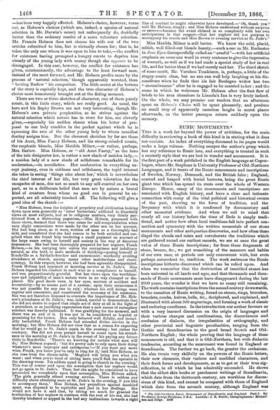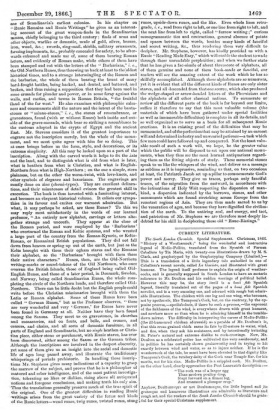RUNIC MONUMENTS.*
Tuts is a work far beyond the power of criticism, for the main. difficulty in reviewing a book of this kind is in stating what it does not contain. An index of everything discussed in its pages would make a large volume. Nothing escapes the author's grasp whick has any reference to Runic lore, and everything is treated in such a masterly style that we are lost in wonder and amazement. It is the first part of a work published in the English language at Copen- hagen, where Mr. Stephens is University Professor of Old-Northern Languages, and it treats of the Runic monuments and inscriptions of Sweden, Norway, Denmark, and the British Isles ; England, scarred and heaped with burial barrows, being the great Runic giant tree which has spread its roots over the whole of Western, Europe. Hence, many of the monuments and inscriptions • are associated with English history, and have a close and intimate connection with many of the vital political and historical events of the past, showing us the force of tradition, and the frequency with which it is confirmed by documentary and other memorial evicTence. And when we call to mind that nearly all our history before the time of Bede is simply tradi- tional, and notice how often local traditions fall into perfect con- nection and symmetry with the written memorials of our stone monuments and other antiquarian discoveries, and how often these dispel the clouds and mists and corroborate the traditions which are gathered round our earliest records, we see at once the great value of these Runic inscriptions ; for from these fragments of stone, bronze, &c., we get something of the manners and habits of our own race, at periods not only concurrent with, but even perhaps antecedent to, tradition. The work embraces the Runic- inscriptions hitherto discovered which can be relied upon. And when we remember that the destruction of inscribed stones has been universal in all lands and ages, and that thousands and thou- sands of Runic monuments must have disappeared during the last 2000 years, the wonder is that we have so many still remaining. The work contains inscriptions from the second century downwards, to the cessation of Runic writing, found on stones, rings, brooches, bracelets, combs, knives, bells, &c., deciphered, and explained, and illustrated with about 500 engravings, and forming a work of classic and enduring excellence. In the introduction our author favours us with a very learned discussion on the origin of languages and their various changes and combinations, the discordances and. confusion of dialects, the irregularities of orthography, and other provincial and linguistic peculiarities, ranging from the Gothic and Scandinavian to the good broad Scotch and Old- Northern English ; the whole proving that the language of these monuments is old, and that it is Old-Northern, but with dialectic tendencies, according as the monument was found in England or Scandinavia. The further we go back, the greater the archaisms. He also treats very skilfully on the powers of the Runic letters, their new elements, their various and modified characters, and their fresh forms and developments, so as to get at their true sig- nification, in all which he has admirably succeeded. He shows that the oldest skin books or parchment writings of Scandinavia, which date from the thirteenth century, are worthless for discus- sions of this kind, and cannot be compared with those of England which date from the seventh century, although England was " The Old-Northern Runic Monuments of Scandinavia and England. Part T. BF Professor George Stephens, F.84. London: J. R. Smith; Ohespinghaven: Idichr.17 son and Tinge. 1866 one of Scandinavia's earliest colonies. In his chapter on "Runic Remains and Runic Writings 't he gives us an interest- ing account of the great weapon-finds in the Scandinavian mosses, chiefly belonging to the third century: finds of arms and other objects, warlike or domestic, made of gold, silver, bronze, iron, wood, &c. ; swords, ring-mail, shields, military ornaments, farming implements, &c., probably concealed for safety, to be after- wards exhumed and made use of, some of them bearing Roman letters, and evidently of Roman make, while others of them have been stamped and cut with the letters of the "Barbarians," i. e., the Old-Northern Runes, thus throwing us back at least to the:oldest historical times, and to a strange intermingling of the Roman and the barbarian, the whole of them bearing the brunt of many hard-fought battles, being hacked, and dented, and battered, and broken, and thus raising a supposition that they had been used in some crusade for plunder and power, or in some foray against the walls, and castles, and towns in Roman Britain, "the fruitful iland of the far west." He also examines with philosophic calm- ness and consummate skill the nature and the intent of the bauta- stones or " minne-stones," i. e., the stones of remembrance, or gravestones, found (with or without Runes) both inside and out- side of the grave-mounds, which bear so striking a resemblance to the customs adopted in the crypts of Egypt and the ancient East. Mr. Stevens considers it of the greatest importance to engrave not the inscription merely, but the whole of the monu- ment, and we must quite agree with him for so doing. This at once brings before us the form, style, and decorations, or its extreme simplicity. All this may be looked upon as a part of the Inscription. Along with the carved words it helps to fix the date and the laud, and to distinguish what is old from what is later, what is heathen from what is Christian, and what is English- northern from what is High-Northern ; on the one a simple, stern plainness, but on the other the worm-twist, with love-knots, and other symbols of elegance and luxuriance. The engravings are mostly done on zinc (chemi-types). They are excellent delinea- tions, and their minuteness of detail evinces the greatest skill in execution. The book is thus invested with a fascinating interest, and becomes an eloquent historical volume. It enlists our sympa- thies in its favour and excites our warmest admiration. But what, it may perhaps be asked, are these Runes? To this we may reply most satisfactorily in the words of our learned professor, "An entirely new alphabet, carvings or letters alto- gether strange and uncouth. They appear at the close of the Roman period, and were employed by the ' Barbarians ' who overturned the Roman and Keltic systems, and who wrested a large part of the country from the Roman-Kymric, or Kelto- Roman, or Romanized British populations. They did not fall down from heaven or spring up out of the earth, but just as the Kelts brought with them their ogham staves and the Romans their alphabet, so the 'Barbarians' brought with them these their native characters." Runes, then, are the Old-Northern writing-marks or sound-tokens of the Old Northmen, who once overran the British Islands, those of England being called Old- English Runes, and those of a later period, in Denmark, Sweden, and Norway, being called Scandinavian Runes, the whole com- pleting the circle of the Northern lands, and therefore called Old- Northern. There can be little doubt but the English people could write before the Christian missionaries brought with them the Latin or Roman alphabet. Some of these Runes have been "German Runes," but as the Professor observes, "these are very wonderful and very 'German,' for Runes have never been found in Germany at all. Neither have they been found among the Saxons. They meet us on gravestones, in churches and monasteries, and on fonts, and bells, and crosses, and -censer's, and chairs, and all sorts of domestic furniture, in all parts of England and Scandinavia, but no single heathen or Chris- tian piece, either atone or parchment, with Runic staves, has ever been discovered, either among the Saxon or the German tribes. Although the inscriptions are involved in the deepest obscurity, yet some of them give us an insight into the social and domestic life of ages long passed away, and illustrate the traditionary whisperings of periods prehistoric. In handling these inscrip- tions Mr. Stephens gives many indications of a capacity to grasp the marrow of the subject, and proves that he is a philosopher of matured and sober intelligence, and of the most patient investiga- tion, tolerating no likes or dislikes, rising above all antiquated notions and foregone conclusions, and making truth his only aim. Thus the translations generally preserve much of the true spirit of the original. One of the greatest difficulties in reading Runic -makings arises from the great variety of the forms and kinds of the Runic letters—wend runes, twig runes, twisted runes, stung: runes, upside-down runes, and the like. Even whole lines retro- grade, 1. e., read from right to left, or one line from right to left, and the next line from left to right, called "furrow writing ;" curious monogrammatic ties and contractions, general absence of points and spaces between the words, besides many kinds of fanciful and secret writing, &c., thus rendering them very difficult to decipher. Mr. Stephens, however, has kindly provided us with a Runic "Reading Made Easy," which will enable the student to wade through these unreadable perplexities ; and when we further state that he has given a fac-simile of about threescore of alphabets, all of them genuine and none of them book-made or fanciful, our readers will see the amazing extent of the work which he has so skilfully accomplished. Although these alphabets are so numerous, yet it is evident that all the different kinds of Runes are only sister staves, and all descended from thatone source, which also produced the wedge-shaped or arrow-headed letters of the Phoenicians and the alphabets of all other classical nations. To enumerate or review all the different parts of the book is far beyond our limits, suffice it therefore to say that this most valuable volume (the materials of which have been gathered under special facilities as well as innumerable difficulties) is complete in all its details, and so well organized as to serve as a basis for all subsequent Runic erections. It is an existing proof of the difficulties that may be surmounted, and of the perfection that may be attained by an earnest will and determined industry and unwearied patience—a task which few men could have followed up and conquered. Not the least valu- able result of such a work will, we hope, be the greater value which the public will be disposed to set upon our national monu- ments, when they thus see the most learned antiquarians regard- ing them as the fitting objects of study. These memorial stones speak to us like the whispers of the wind, and deliver us a message as sublime as it is impressive, reminding us that, on two occasions at least, the Patriarch Jacob set up a pillar to commemorate God's power and mercy. They give us traces, perhaps only fanciful traces, of the migration from the eastward, in accordance with the intimations of Holy Writ respecting the dispersion of man- kind, a dispersion indicated by the barrows, stones, and other monuments which are found stretching acroea Europe from the remotest regions of Asia. They are thus made sacred to us by the veneration of ages, and because they have dignified the civiliza- tion of the earth. To the untiring zeal, and energy, and tact, and patriotism of Mr. Stephens we are therefore most deeply in- debted for his skill in deciphering these old "Rune-listings."































 Previous page
Previous page